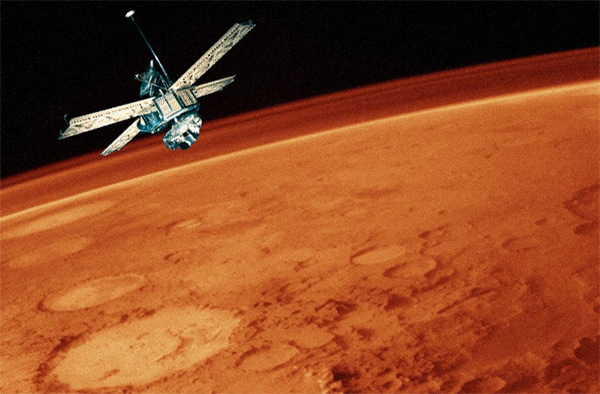The Brave Story of Mars' McClure-Beverlin Escarpment
Mariner 6 orbits above the Martian atmosphere.
In January, NASA’s Opportunity rover found a strange, jelly-doughnut-shaped rock on Mars that seemed to appear from nowhere. Further investigation revealed that the rover had simply kicked the rock as it roved. With the mystery solved, the agency announced that Opportunity would be leaving the jelly doughnut rock site and head uphill on its way to a site known as the McClure-Berverlin Escarpment.
The escarpment, as the name suggests, honors two men. Bill McClure and Jack Beverlin are the two technicians who saved Mariner 6.
The Mariner program was among NASA’s earliest efforts to explore the inner solar system. The program kicked off in 1960 as one designed to launch a series of small-scale missions on the new Atlas launch vehicles. They would follow fairly quickly one after another, and they would fall under the management NASA’s Jet Propulsion Laboratory. As an offshoot of the Mariner missions, these flights were designed to help develop JPL’s Deep Space Network in anticipation of longer mission further into space.
All the Mariner spacecraft had certain features in common. They all had solar panels designed to point towards the sun and dish antenna that would face towards the Earth throughout the flights. They were all also armed with a series of scientific instruments and cameras. In the case of Mariner 6, it boasted two TV cameras, infrared and ultraviolet spectrometers, an infrared radiometer, a celestial mechanics experiment, and an S-band occultation experiment.
Mariner 6 had a twin, Mariner 7, and together these spacecraft made up NASA’s first dual mission to the red planet. Flying over the equator and south polar region, they gathered atmospheric and surface data. They relayed more than 200 pictures back to Earth and more than 800 million bits of data. Among the images were a series of close-ups that allowed scientists to map about 20 percent of the surface.
Both missions were stunning successes for NASA, but Mariner 6 almost didn’t make it off the launch pad.
In the middle of February 1969, Mariner 6 was just about ready to launch. It was mated to its Atlas rocket, which was itself standing in prelaunch readiness on a launch pad at NASA’s Cape Canaveral launch site. Then, just ten days before the scheduled launch, a faulty switch opened one of the main valves on the Atlas stage.
This Atlas family of rockets is probably best known as the vehicle that launched the orbital Mercury missions beginning with John Glenn’s 1962 Friendship 7 flight. It’s also the rocket whose aluminum skin was so thin it had to be pressurized to stand on the launch pad and support the weight of its payload.
In the case of Mariner 6’s Atlas, once the valve opened and the pressure inside the booster began bleeding out and the 12-story rocket started to deflate and crumple. Bill McClure and Jack Beverlin were among the ground crewmen who responded to the incident. With the crumbling Atlas looming overhead and threatening to fall on top of them, they started the pressurizing pumps. It was a dangerous operation that put them both at risk.
McClure and Beverlin managed to stem the outflow of gas from the rocket and stabilize it, preventing it from collapsing any further. The rocket was damaged but eventually secured and Mariner 6 was safely removed. It was mated to another Atlas and launched, on schedule, from launch complex 36B on February 25, 1969.
For their role in saving the mission, McClure and Berverlin were awarded NASA’s Exceptional Bravery Medals as well as the feature on Mars named in their honor.(Mar 3, 2014 05:17 PM ET // by Amy Shira Teitel)












